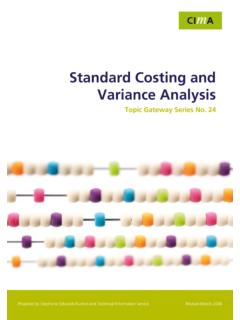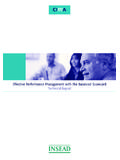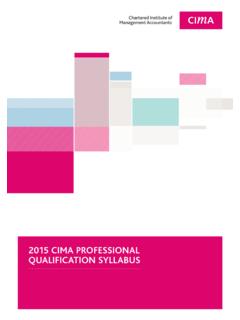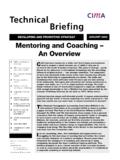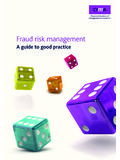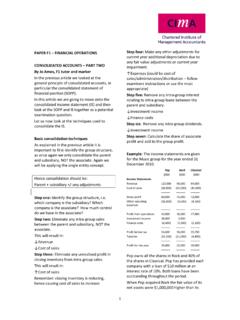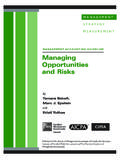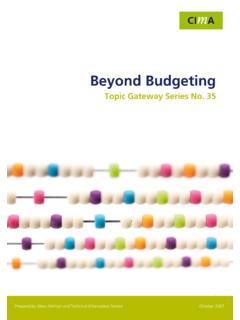Transcription of Budgeting Topic Gateway - CIMA
1 Budgeting Topic Gateway Series 1 Budgeting Topic Gateway Series No. 27 Prepared by Louise Ross and Technical Information Service Revised March 2008 Budgeting 2 Topic Gateway Series About Topic Gateways Topic Gateways are intended as a refresher or introduction to topics of interest to CIMA members. They include a basic definition, a brief overview and a fuller explanation of practical application. Finally they signpost some further resources for detailed understanding and research. Topic Gateways are available electronically to CIMA members only in the CPD Centre on the CIMA website, along with a number of electronic resources. About the Technical Information Service CIMA supports its members and students with its Technical Information Service (TIS) for their work and CPD needs. Our information specialists and accounting specialists work closely together to identify or create authoritative resources to help members resolve their work related information needs.
2 Additionally, our accounting specialists can help CIMA members and students with the interpretation of guidance on financial reporting, financial management and performance management, as defined in the CIMA Official Terminology 2005 edition. CIMA members and students should sign into My CIMA to access these services and resources. The Chartered Institute of Management Accountants 26 Chapter Street London SW1P 4NP United Kingdom T. +44 (0)20 8849 2259 F. +44 (0)20 8849 2468 E. Budgeting Topic Gateway Series 3 Budgeting Definition and concept A budget is: 'A quantitative expression of a plan for a defined period of time. It may include planned sales volumes and revenues, resource quantities, costs and expenses, assets, liabilities and cash flows.' CIMA Official Terminology, 2005 Budgeting practices are heavily influenced by the organisation's management style and can vary considerably, but the theory is common to all.
3 Given the relationship between budgets and planning, readers might also like to refer to the Planning and Forecasting Topic Gateway . [Accessed 11 March 2008] Context In the current syllabus, CIMA students will learn and may be examined on the fundamentals of this Topic in Certificate of Business Accounting 2006, Fundamentals of Management Accounting, Fundamentals of Business Mathematics and Fundamentals of Business Economics. At professional qualification (managerial level), students will learn and may be examined on the management aspects of this Topic in paper P1 Management Accounting Performance Evaluation, paper P2 Management Accounting Decision Management and paper P4 Organisational Management and Information Systems. At Professional Qualification (Strategic level), students will learn and may be examined on the strategic aspects of this Topic in paper P3 Management Accounting Risk and Control Strategy, paper P6 Management Accounting Business Strategy and paper P9 Management Accounting Financial Strategy.
4 Budgeting Topic Gateway Series 4 Overview Budgeting is the process of expressing the predicted costs and resources for a planned course of action over a specified time period. Budgets can be drawn up for business units, departments, products, teams or the entire organisation (see master budget below). Another term for a budget is a financial plan, but budgets can refer to non-cash resources, such as staff or time. Budgeting helps all types of organisation to plan and control their operations, and to support their managerial strategies. A budget sets out the benchmark against which performance will be measured. For example, this might be the minimum profit and loss performance expected by senior management. Performance against budget may be part of the organisation s appraisal system for individuals who are deemed accountable for such performance. Therefore budgets are a management tool, expressed in quantitative terms because this is the easiest way to prioritise and co-ordinate complex competing decisions throughout the organisation.
5 However, budgets may be dismissed as a finance tool because they usually originate from the finance department and involve numbers. An unenlightened manager might undervalue their contribution. Budgets are often unpopular because of the time and effort spent on preparing and negotiating them, or explaining variances. One school of thought believes that Budgeting contributes to information overload, restricts management action and generally drains rather than contributes to the organisation. This has led to the development of alternative approaches to traditional Budgeting . Budgeting Topic Gateway Series 5 In practice The main purposes of Budgeting relate to planning and control, and supporting the achievement of strategic plans by: 1. Translating the long-term plan into an annual work programme. 2. Co-ordinating the various departments of the organisation to ensure they are working in harmony. A budget requires managers to consider the relationship between their operations and those of other departments.
6 Otherwise, managers might make decisions in their own interests, rather than the company's best interests. 3. Communicating plans to those who will be held accountable. Each department or individual should understand what role they play in helping the organisation achieve its plans. Key individuals are held accountable for the outcome of departments or teams, known as budget centres. A budget centre is: 'A section of an entity for which control may be exercised through prepared budgets. It is often a responsibility centre where the manager has authority over, and responsibility for, defined costs and (possibly) revenues.' CIMA Official Terminology, 2005 In addition to the allocation of resources, Budgeting also provides the authority for expenditure. It may be used to motivate staff by including performance against budget in the organisation's remuneration scheme. Process The Budgeting process comprises: 1. Prioritisation of objectives identified in the planning process.
7 2. Assessment and quantification of total available resources, both financial and non-financial 3. Identification and quantification of the inputs and processes required to fulfil the stated objectives and the associated financial resource required. The role of each function and its significance in achieving the objectives should be taken into account. In setting budgets, consideration should be given to the inclusion of a non-allocated contingency element. This is so that reasonable allowance can be made for changes which cannot be reasonably anticipated in time or value. Budgeting Topic Gateway Series 6 4. Assignment of proportion(s) of the total resources necessary to acquire/manage inputs to achieve the stated objectives. Each dedicated proportion of the total resource constitutes a 'budget'. Source: CIMA guide to devolved Budgeting Seasonal variations will be included so that the budget is as realistic as possible.
8 The budget is fixed once it has been agreed it is not changed during the period. This is to preserve its value as a fixed reference point. Changing circumstances or new information which affects the budget can be accommodated by budget flexing, or rolling budgets. Rolling or continuous budget A rolling or continuous budget is: 'A budget continuously updated by adding a further accounting period (month or quarter) when the earliest accounting period has expired. Its use is particularly beneficial where future costs and/or activities cannot be forecast accurately. See rolling forecast.' CIMA Official Terminology 2005 Rolling forecasts are sometimes used instead of rolling budgets. You can read more about forecasting in the Planning and Forecasting Topic Gateway . [Accessed 11 March 2008] Budget flexing Where there is a lot of uncertainty or volatility, it is possible to produce flexed budgets to anticipate performance at different levels of activity.
9 The budget is still fixed, but it has some predefined and explained tolerance. Budget flexing is defined as: 'Flexing variable costs from original budgeted levels to the allowances permitted for actual volume achieved while maintaining fixed costs at original budget levels. Variable cost allowance = ratio of actual volume achieved: budget volume x original budget variable cost.' CIMA Official Terminology 2005 Budgeting Topic Gateway Series 7 Different types of budget There are several different types of budget, depending on their purpose, and they fit together in a cascade. Master budget. At the top of the cascade is the master budget, a suite of statements with strong similarity to the published financial accounts.
10 This budget consolidates all subsidiary budgets and usually comprises the budgeted profit and loss account, balance sheet and cash flow statement. Senior management performance is often considered in relation to its effect on the balance sheet P&L or other financial information which is reported externally to investors and analysts. Cash budget. This is a detailed budget of estimated cash inflows and outflows incorporating both revenue and capital items. Capital Budgeting . This is a process concerned with decision making in respect of specific investment project choices and the total amount of capital expenditure to commit. Operating budget. This is the budget of the revenue and expenses expected in a forthcoming period. Budgets can include financial indicators such as cash, profit/loss, working capital and non-financial items such as staff numbers, orders and volumes of output. Progress is monitored regularly (typically monthly) by comparing actual performance against budget.
